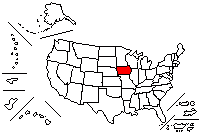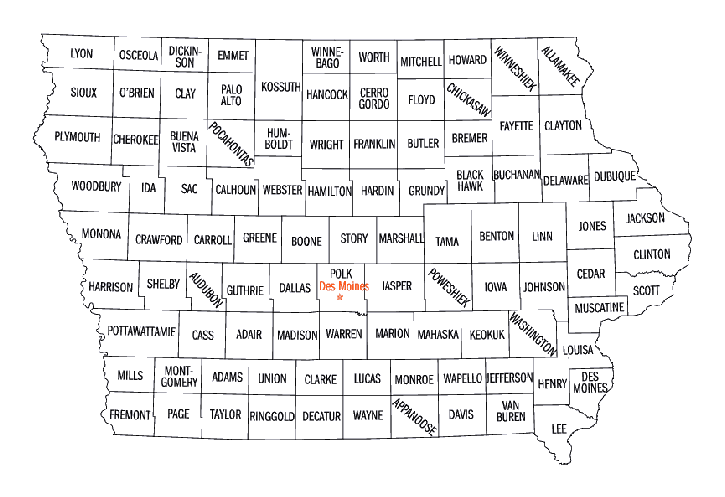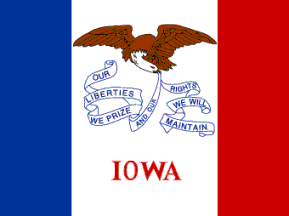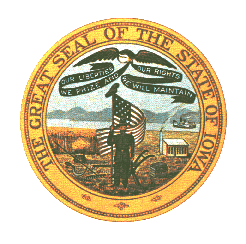
 |
|

















Iowa State Song |
La Canción del |


Flag:
Iowa was almost 75 years old before the state flag was adopted by the
General Assembly. Creation of the state flag had been suggested for
years by patriotic organizations, but no action was taken until World
War I, when Iowa National Guardsmen stationed along the Mexican border
suggested a state flag was needed to designate their unit. This prompted
the state's Daughters of the American Revolution (DAR) to design a flag in 1917.
The Iowa General Assembly officially adopted the design in 1921. Designed by Mrs.
Dixie Cornell Gebhardt of Knoxville, Iowa, a member of the DAR,
the state flag consists of three vertical stripes -- blue, white and red.
Gebhardt explained that the blue stands for loyalty, justice and truth;
the white for purity; and the red for courage. On the white center stripe
is an eagle carrying in its beak blue streamers inscribed with the state
motto: "Our liberties we prize, and our rights we will maintain." The word
"Iowa" is in red just below the streamers. All schools must fly the state flag
on school days. The flag may also be flown on the sites of public buildings.
When displayed with the United States flag, the state flag must be flown below
the national emblem.
Bandera:
Pasó casi 75 años antes que la bandera de Iowa fuera adoptada por la
Asamblea General. La creación de la bandera del estado había sido sugerido por muchos
años por organizaciones patióticas, pero no tomaron acción hasta la primera guerra mundial,
cuando Soldados Nacionales de Iowa estacionados a lo largo de la frontera de México
sujirieron que una bandera del Estado era necesario para distinguir su unidad. Esto incitó a las Hijas de la Revolución Americana (DAR siclas en inglés)
del estado a diseñar una bandera en el 1917.
La Asamblea General de Iowa oficialmente adoptó el diseño en el 1921. Fué diseñada por
la Sra. Dixie Cornell Gebhardt de Knoxville, Iowa, una miembro del DAR,
la bandera del estado consiste de tres rayas verticales - azul, blanco y rojo. Gebhardt
explicó que el azul representaba lealtad, justicia y verdad;
el blanco la pureza; y el rojo valentía. En el centro de la raya blanca está un águila
llevando en su pico una cinta azul inscrita con el lema del estado. La palabra Iowa está
en rojo debajo de la cinta. Todas las escuelas deben enarbolar la bandera del Estado. La bandera
tiene que también ser enarbolada en los edificios públicos. Cuando de iza la bandera de los
Estados Unidos, la bandera del estado deberá ir debajo.

Iowa
Capital City: Des Moines - Founded at the confluence of the Des Moines and Raccoon rivers;
originally a military outpost.
Admission to Statehood: December 28, 1846
National: Iowans
Border States: Illinois / Minnesota / Missouri / Nebraska / South Dakota / Wisconsin
Motto: Our liberties we prize and our rights we will maintain
This motto, expressing
the sentiment of Iowans as they entered the Union in 1846, was placed on the state seal
by the first General Assembly in 1847.
Nickname: Hawkeye State - The nickname was adopted early in the state's history.
Two Iowa promoters from Burlington are believed to have popularized the name.
Iowa (se pronuncia á-i-o-wa en inglés y español)
Ciudad Capital: Des Moines (se pronuncia Des-Mó-iins en ambos idiomas) Fundado en la confluencia
de los ríos Des Moines y Raccoon; originalmente era un puesto militar.
Admición como estado: 28 de diciembre de 1846
Gentilicio: Ioweño (se pronuncia ái-o-u-eño en ambos idiomas)
Estados limítrofes: Illinois / Minnesota / Missouri / Nebraska / South Dakota / Wisconsin
Lema: Nuestras libertades valoramos y nuestros derechos mantendremos
Este lema expresa el sentimiento de los Ioweños cuando ellos entraron a la Unión en el 1846,
fué colocado en el sello estatal por la primera Asamblea General en el 1847.
Cognómento: Estado Ojo de Halcón - fué adoptado temprano en la historia del estado. Se cree que popularizaron el nombre
dos partidiarios de Iowa de Burlinton.


The Seal:
The Great Seal of the state of Iowa was made official by Iowa's first state
legislature in 1847. The eagle and the scroll with the state's motto are also used on Iowa's
flag. The motto reads "Our liberties we prize and our rights we will maintain."
In the middle of the seal, a soldier stands in a field of wheat, holding an American
flag. A cultivator rests in the field behind him, smoke trails from the chimney of a
small cabin, and a ship steams through the water in the background.
The Great Seal cannot be used without the permission of the Governor.
The state seal is retained in the custody of and under the control of
the Governor, who uses the seal for official documents and functions.
El Sello
El Gran Sello del Estado de Iowa fué oficialisado por la primera legislatura del Estado
en el 1847. El águila y el pergamino con el lema del estado son usado en la bandera del
Iowa. El lema dice:"Nuestras Libertades apreciamos y nuestros derechos mantendremos".
En el medio del sello, un soldado está parado en un campo de trigo, sosteniendo una
bandera americana. Un agricultor descansa en el campo detrás de él, sale humo de la chimenea
de la pequeña cabaña y una embarcación de vapor atraviesa el agua en el fondo.
El Gran Sello no puede ser utilizado sin el consentimiento del Governador.
Es sello estatal es mantenido en custodia y bajo control del Governador, quien lo utiliza
para documentos y funciones oficiales.

HISTORY
Iowa, in the heart of the Midwest, is a state in transition.
Its location marks a transition from the eastern hardwood forests
in its northeast to the prairies that stretch westward to the Rockies.
With agricultural industries in its eastern cities, particularly
Waterloo and Davenport, it marks a transition between the eastern
manufacturing belt and the less industrial West. The state is
currently in transition from an agricultural economic base, both
in terms of production and a whole array of agribusiness, to a more
diversified economy. Iowa is the land between the rivers--the Missouri
and the Mississippi. It is bordered by Minnesota, South Dakota,
Nebraska, Missouri, Illinois, and Wisconsin.
Paleo-Indians occupied what is now Iowa as long as 13,000 years ago,
as soon as glacial ice retreated. These early people were hunters.
Substantial archaeological evidence shows significant waves of Indian
culture through Iowa and the surrounding areas of North America.
The Woodland culture dominated from 500 BC to AD 800, with the Adena
in the early part followed by the Hopewell. The Woodland peoples had
small villages and practiced a primitive agriculture. They were
succeeded by the Mississippian culture with the Oneonta tribe
resident in Iowa. These people left the effigy mounds along the
Mississippi. At the time of European contact, the Illinois, a
northeast tribe, occupied extreme southeastern Iowa. Three Great
Plains tribes--the Iowa, Santee, and Yankton--controlled the rest.
European Settlement
Although Louis Jolliet and Jacques Marquette traveled down the
Mississippi River in 1673, significant European contact with
Iowa came much later. Julien Dubuque, who mined lead along the
Mississippi, established a permanent base in 1788. The land that
was to become Iowa became part of the United States with the
Louisiana Purchase in 1803, and the following year the Lewis
and Clark Expedition traveled up the Missouri River. The Sauk
and Fox (Mesquakie) tribes, forced into the Mississippi River
valley from Wisconsin and Illinois by the oncoming pressure of
white settlement, defeated the Iowa Indians and occupied their
lands in the late 18th and early-19th centuries. Following the
Black Hawk War of 1832, the resistance of these tribes to white
settlers was broken, and the land was opened to pioneer settlement.
The first legal settlement west of the Mississippi took place in 1833.
Successive purchases from the Indians led to settlement throughout
the area of the state in the 1830s and '40s--but not without
confrontations, the last being the Spirit Lake Massacre of 1857.
Just before this event (in 1856) the Mesquakies, who had been
forced to move to Kansas, convinced the Iowa legislature to permit
their repurchase of land along the Iowa River near Tama.
The Mesquakie Settlement now covers about 13 sq./km. (5 sq./mi. ).
Statehood and Settlement
Iowa gained territorial status in 1838 with its capital in Iowa City.
Statehood came in 1846 with the boundaries extended west to the
Missouri. The population was little more than 100,000, but the U.S.
Congress needed a free state to admit in conjunction with a new slave
state, Florida. The capital was moved to the more central location of
Des Moines in 1857.
Early white settlement in Iowa mainly came from other states,
especially Ohio and New York. The early settlers were involved
in agriculture and commerce, and from the beginning Iowa was
linked commercially with the rest of the nation. Significantly,
many of these early settlers, having already made previous moves,
later moved westward again. The population grew rapidly, to 192,000
by 1850 and 675,000 by 1860, then to 1,194,000 by 1870.
The location of railroads quickly became an important political
(and commercial) issue. Connections to the growing rail network
became a requirement for the success of towns. River locations
also were highly advantageous, as evidenced by the fact that all
towns that became economically successful were both along rivers
and attracted a rail line. Some rivers were important sources of
energy, as connoted by the names of such towns as Cedar Rapids,
Cedar Falls, and Iowa Falls.
The Civil War and Postwar Periods
The slavery issue and the American Civil War had a significant impact
on Iowa, although the state suffered no actual fighting on its soil.
At first a bastion of the Democratic party, Iowa swung strongly to the
Republican party after its formation in Iowa in 1856. Iowans
participated in the underground railway that helped runaway slaves
escape to Canada. Almost 80,000 Iowans fought in the Civil War, a
larger portion of Iowa's population than that of any other Union
state. After the war, suffrage was extended to blacks, and schools
were integrated.
The years after the Civil War brought the completion of the settlement
of Iowa and continued growth of the transportation network. The
state achieved a fairly well distributed rural population, with the
overwhelming majority farming their own land. Iowa farming was
commercial rather than subsistence, and a number of problems beset
farmers. Floods, droughts, and pests plagued production, and economic
depressions plagued their markets. Price gouging by railroads
and distrust of banks and politicians led to the formation of
agrarian movements, such as the Granger movement. The development
of the "Corn Belt" in the late 19th century illustrates the commodity
compartmentalization of agriculture in the Midwest. By 1880 much of
Iowa had adopted a corn-hog agricultural production pattern.
Feed corn, fed on the site to a farmer's own hogs, became the prime
crop. The farmer then transported the hogs to the great slaughtering
houses that developed in the major urban markets.
As the United States changed from an agricultural to an industrial
country in the half century from 1870 to 1920, Iowa played a vital
role in feeding the nation. Eastern Iowa became part of the
manufacturing belt, particularly with the production of tractors
and other farm equipment. Innovation, especially hybridization of
corn and mechanization, paved the way for more efficient and
productive farming.
The internal-combustion engine and electricity transformed life in
Iowa, effectively reducing distances, increasing work capacities,
and reorienting the scale of people's daily activities. Farmers were
no longer isolated, and their lives increasingly became focused on
the larger towns.
Iowa, en el corazón del Cercano oeste, es un estado en
transición. Su localización marca una transición de los bosques
del este de la madera dura en su noreste a las praderas que estiran
hacia el oeste a las Rocallosas. Con industrias agrícolas en sus
ciudades del este, particularmente Waterloo y Davenport, marca una
transición entre la correa del este de la fabricación y el oeste
menos industrial. El estado está actualmente en la transición de
una base económica agrícola, en términos de la producción y de un
arsenal entero de negocio agrícola, a una economía diversificada.
Iowa es la tierra entre los ríos -- el Missouri y el Mississippi. Es
limitado por Minnesota, Dakota del sur, Nebraska, Missouri, Illinois,
y Wisconsin.
Indios Paleo ocuparon lo que es ahora Iowa hace
13.000 años, tan pronto como el hielo glacial se retirara. Éstas gente
eran cazadores. La evidencia arqueológica substancial
demuestra ondas significativas de la cultura india con Iowa y los
alrededores de Norteamérica. La cultura del bosque dominó a
partir del 500 A.CC. al 800. La gente del bosque tenía aldeas
pequeñas y practicaron una agricultura primitiva. Ellos fueron
substituido por la cultura mississipiana de la tribu de Oneonta
que tuvo éxito
en Iowa. Éstos pueblan a la izquierda los montones Effigy a lo largo
del Mississippi. A la hora de contacto europeo, los Illinois, una
tribu del noreste, ocupaba el extremo sudeste de Iowa.
Tres tribus de los
grandes llanos -- el Iowa, el Santee, y el Yankton -- controlaron el
resto.
El establecimiento europeo
Aunque Louis Jolliet y Jacques
Marquette viajaron rio abajo del Mississippi en 1673, el contacto europeo
significativo con Iowa vino mucho más adelante. Julien Dubuque, que
minó el plomo a lo largo del Mississippi, estableció una base
permanente en 1788. La tierra que debía convertirse en Iowa se
convirtió en parte de los Estados Unidos con la compra de Luisiana en
1803, y el año siguiente la expedición de Lewis y de Clark viajó
al norte del río de Missouri. Las tribus de Sauk y Fox
(Mesquakie), forzados en el valle del Río Mississippi desde
Wisconsin y de
Illinois por la continua presión del establecimiento blanco, fueron
derrotadas las fuerzas indias de Iowa y ocupadas sus tierras en los últimos
siglos los décimo octavos y principio del 19. Después de la guerra
negra del halcón de 1832, la resistencia de estas tribus a los
colonos blancos estaba quebrada, y la tierra fue abierta para iniciar
el establecimiento. El primer establecimiento legal al oeste del
Mississippi ocurrió en 1833. Las compras sucesivas de tierras a los indios
condujeron al establecimiento a través del área del estado en el
1830s y el ' 40s -- pero no sin las confrontaciones, el último fué
la masacre del Spirit Lake de 1857. Momentos antes de este
acontecimiento (en 1856) los Mesquakies, que había sido forzado para
moverse a Kansas, convencieron a la legislatura de Iowa que permitiera
recomprar las tierra a lo largo del río de Iowa cerca de Tama. Las tierra de
los Mesquakes tenían ahora 13 sq./km.
(5 sq./mi.).
Estadidad
Iowa ganó estado territorial en 1838 con su capital en Iowa City.
La Estadidad vino en 1846 con los límites ampliados al oeste al
Missouri. La población era poco más de 100.000, pero
el congreso los Estados Unidos
necesitaba un estado admitir un estado abolicionista
conjuntamente con un estado esclavista, la Florida.
La capital fue movido a la
localización más central de DES Moines en 1857. El establecimiento
blanco en Iowa vino principalmente de los otros estados,
especialmente Ohio y de New York. Los colonos estuvieron
implicados en agricultura y comercio, y Iowa, que comenzaba, fué
ligado comercialmente al resto de la nación. Perceptiblemente,
muchos de estos colonos, ya haciendo movimientos anteriores,
se movieron más adelante hacia el oeste otra vez. La población
creció rápidamente, a 192.000 antes de 1850 y 675.000 antes de 1860,
entonces a 1.194.000 antes de 1870. La localización de ferrocarriles
se convirtió en rápidamente una edición política (y anuncio)
importante. Las conexiones a la red cada vez mayor del ferrocarril se
convirtieron en un requisito para el éxito de ciudades. Las
localizaciones del río también eran altamente ventajosas, según lo
evidenciado por el hecho de que todas las ciudades que llegaron a ser
económicamente acertadas eran ambas a lo largo de los ríos y
atrajeron una línea del ferrocarril. Algunos ríos eran fuentes
importantes de energía, tenían los nombres de las
ciudades tales que como Cedar Rapids, Cedar Falls y Iowa Falls.
La guerra civil y la posguerra
El asunto de la esclavitud y la guerra civil americana tenían un
impacto significativo en Iowa, aunque el estado no sufrió ningún
luchar real en su suelo. Al principio un bastión del partido
democrata, Iowa giró fuertemente al partido republicano
después de su formación en Iowa en 1856. Los Ioweños participaron en el
ferrocarril subterráneo que ayudó a esclavos fugitivos a
escaparse a Canadá. Casi 80.000 Ioweños lucharon en la guerra civil,
una gran porción de la población de Iowa que el de cualquier otro
estado de la unión. Después de la guerra, el sufragio fue ampliado
a los negros, y las escuelas fueron integradas. Los años después de
que la guerra civil trajera el término del establecimiento de
Iowa y continuara el crecimiento de la red del transporte. El estado
alcanzó a una población rural distribuida bastante bien, con la
mayoría abrumadora cultivando su propia tierra. La agricultura de Iowa
era comercial más bien que de subsistencia, y un número de problemas
sitiaron a granjeros. Las inundaciones, las sequías, y los
parásitos plagaron la producción, y las depresiones económicas
plagaron sus mercados. El escopleo de precio por los
ferrocarriles y la desconfianza de los bancos y de los políticos
condujo a la formación de movimientos agrarios, tales como el
movimiento de Granger. El desarrollo del "Corn Belt"
a fines del siglo XIX ilustra la compartimentalización de la materia
de la agricultura en el Cercano oeste. Antes de 1880 muchos en Iowa
había adoptado un patrón de la producción agrícola del
maíz-cerdo. Alimentando con maíz a los cerdos del granjero,
hizo la cosecha de primera. El granjero entonces
transportó los cerdos a las grandes casas de la matanza que se
convirtieron en los mercados urbanos principales. Como los Estados
Unidos cambió de un agrícola a un país industrializado en el medio
siglo a partir de 1870 a 1920, Iowa desempeñó un papel vital en la
alimentación de la nación. Iowa del este se convirtió en parte
de
correa de la fabricación, particularmente con la producción de los
tractores y del otro equipo de granja. La innovación, especialmente
hibridación del maíz y mecanización, pavimentó la manera para
cultivar más eficiente y más productivo. La electricidad y El motor
de combustión interna transformaron vida en Iowa, con eficacia
reduciendo distancias, capacidades de aumento de trabajo , y la
reorientación de la escala de las actividades diarias de la gente.
Los granjeros ya no estaban aislados, y sus vidas cada vez
más se centraron en las ciudades más grandes.
